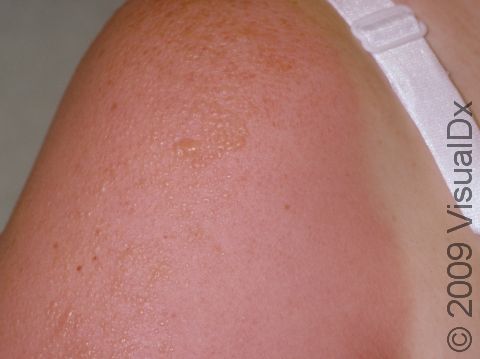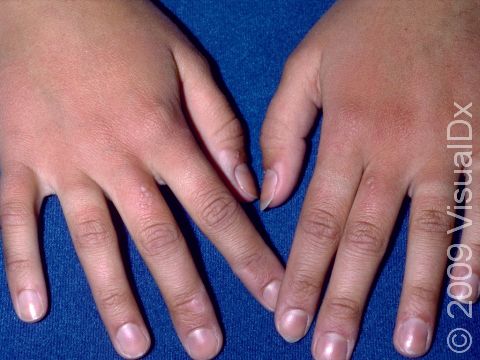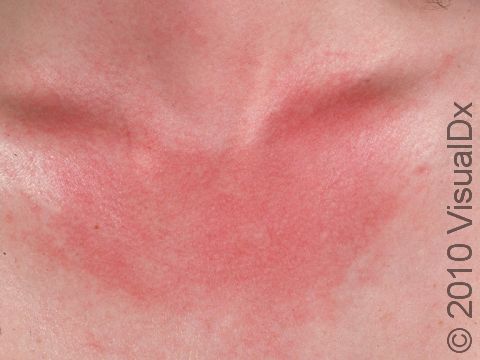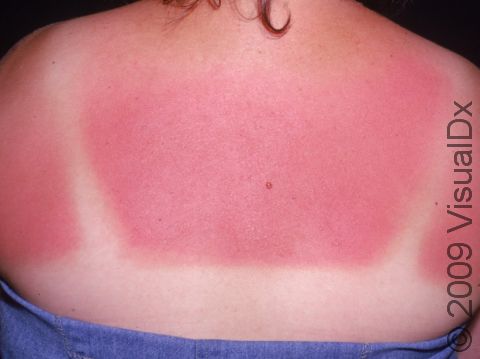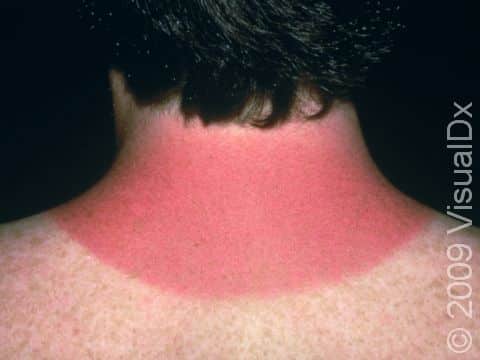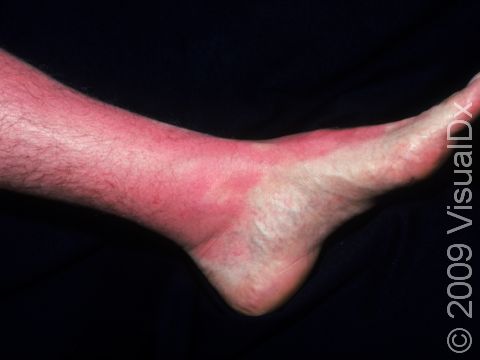Sunburn
Sunburn is caused by the skin’s reaction to ultraviolet light exposure from the sun. It appears around 4 to 24 hours after the exposure. The affected skin is red and may be painful or blistered. When sunburn subsides, peeling of the skin may be seen.
Some medical conditions, such as lupus and porphyria, as well as some oral medications, most commonly hydrochlorothiazide (a blood pressure medication), may make the skin more sensitive to sunburn.
Getting a sunburn raises the lifetime risk of developing skin cancer (eg, melanoma, basal cell carcinoma, squamous cell carcinoma). Sunburn and sun exposure also increase wrinkling and other signs of premature aging in the skin. Additionally, it is important to know that tanning beds are a source of the same light that cause sunburns, premature aging, and skin cancer.
Who's At Risk?
Sunburn occurs in people of all ages, particularly in individuals with lighter skin colors. People with darker skin colors have more pigment (melanin), which is protective, but sunburn and/or tanning of the skin can occur, except in the darkest skin colors, and no one is immune to developing skin cancer.
Signs & Symptoms
Sunburn may occur on any sun-exposed area. Sunburn appears as immediate redness as soon as 4 hours after exposure, followed by deep redness and blister formation in severe sunburn. Long-lasting redness may be present for weeks after the actual burn.
Self-Care Guidelines
If you get a sunburn, further direct sun exposure should be avoided for a few days. Cool water or cool milk soaks may help cool and soothe the affected areas. Acetaminophen (Tylenol) and ibuprofen (Advil, Motrin) can help decrease the redness and pain. Be sure to drink lots of fluids while recovering from your sunburn.
Note that applying a greasy cream or ointment may actually make the pain worse by trapping heat on the skin.
Do not attempt to break any blisters that form; you can cover them with gauze, if necessary. If any blisters break on their own, a topical antibiotic ointment (eg, Neosporin) can be applied. A moisturizer can help with skin peeling afterward. Avoid topical products that end in “caine,” such as lidocaine, as they can sometimes further irritate the skin.
Prevention is very important. To reduce the risk of skin cancer later in life, it is important to prevent sunburns.
- Avoid direct sun in the middle of the day (10 AM to 3 PM). Be mindful that snow and water reflect light to the skin. Also note that clouds still let a lot of light through, so you can still be exposed to ultraviolet light even on cloudy days.
- Wear a hat with a wide brim. Baseball hats do not provide as much protection.
- Cover up with tightly woven clothing. Some manufacturers make specialty clothing with an ultraviolet protection factor (UPF) rating.
- Use sunscreen on all exposed skin areas, including the lips, before going outdoors. A broad-spectrum sunscreen (meaning it blocks UVB and UVA light) with an SPF of at least 30 is best. Apply sunscreen generously 30 minutes before going outdoors, and reapply every 2 hours or after swimming or sweating a lot. Sunscreen sprays tend not to provide a thick enough layer on your skin. Therefore, sunscreen lotions or creams are recommended.
- Avoid using tanning beds.
If you have had several sunburns, regularly perform self-examinations to look for signs of skin cancer. It is best to perform the examination in a well-lit area following a shower or bath. Use a full-length mirror with the added assistance of a hand mirror, as necessary. Using a hair dryer can help you examine any areas of skin covered by hair, such as your scalp.
- In front of a full-length mirror, inspect the front of your body, making sure to look at your neck, chest (including under breasts), legs, and genitals.
- With your arms raised, inspect both sides of your body, making sure to examine your underarms.
- With your elbows bent, examine the front and back of your arms as well as your elbows, hands, fingers, areas between your fingers, and fingernails.
- Inspect the tops and bottoms of your feet, the areas between your toes, and your toenails.
- With your back to the mirror and holding a hand mirror, inspect the back of your neck, shoulders, legs, and buttocks.
- Using a hand mirror, examine your scalp and face.
As you perform your monthly self-examination, familiarize yourself with the moles, freckles, and other marks on your body, and look for any changes in them from month to month, including changes in shape, size, color, and other changes, such as moles that bleed or itch.
Treatments
For severe burns, in addition to pain-relieving medicine (usually NSAIDs, such as ibuprofen [Tylenol] and naproxen [Aleve]), your medical professional may prescribe a topical steroid cream or lotion, or prednisone, an oral steroid, to help reduce the inflammation.
Visit Urgency
Sunburn does not usually require a medical professional’s care. If you have a fever, however, see a medical professional because that indicates possible heatstroke. Additionally, if you are burned over a large portion of your body and there is severe discomfort and inflammation, seek medical attention. Also seek medical advice if there are signs of infection (such as swelling, pus, or blisters that turn yellow or red).
References
Bolognia J, Schaffer JV, Cerroni L. Dermatology. 4th ed. Philadelphia, PA: Elsevier; 2018.
James WD, Elston D, Treat JR, Rosenbach MA. Andrew’s Diseases of the Skin. 13th ed. Philadelphia, PA: Elsevier; 2019.
Kang S, Amagai M, Bruckner AL, et al. Fitzpatrick’s Dermatology. 9th ed. New York, NY: McGraw-Hill Education; 2019.
Last modified on June 13th, 2024 at 1:27 pm

Not sure what to look for?
Try our new Rash and Skin Condition Finder
